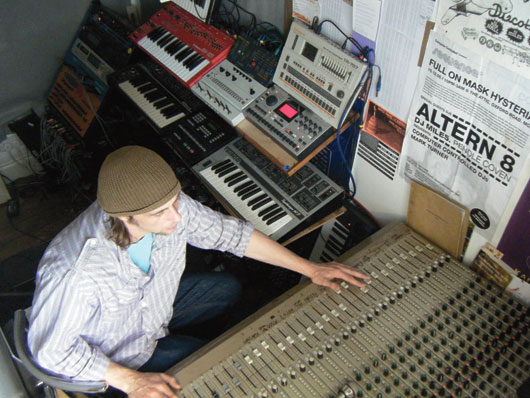In the Studio: Miles Whittaker
Miles Whittaker is the long, tall, shaggy-haired Lancastrian gentleman behind the dub/tech/house monikers MLZ and […]

Miles Whittaker is the long, tall, shaggy-haired Lancastrian gentleman behind the dub/tech/house monikers MLZ and Millie, and one half of the groups Pendle Coven, with Gary Howell, and Demdike Stare, with Sean Canty of the Finders Keepers vinyl collective. All his projects are different but share a dark, autumnal, primeval vibe. With Demdike Stare, especially, Whittaker has been on a tear of late, releasing three LPs of original material—a cryptic marriage of techno from Detroit and Berlin circa ’93, British hardcore/rave of roughly the same period, and imaginary soundtrack/library recordings by way of Asia Minor—and two mix CDs in 2010 alone. We tracked down Whittaker in his studio in the borough of Pendle, about 30 miles outside of Manchester, to hear more about the projects.
XLR8R: How does place, in particular the north of England, where you’re from, affect your production, its tones and overtones?
Miles Whittaker: It’s definitely influencing the music. The weather is wet, grey, and oppressive most of the year, the countryside is bleak, and the culture quotient leaves a lot to be desired. The post-industrial landscapes that have appeared in the last couple of decades have made this part of the UK quite devoid of growth in both economic and cultural terms; of course, this can be turned into inspiration if one is objective enough.
Describe your work space and the type of gear we’d find there.
The set-up varies wildly, as I’m a little obsessive about rebuilding the studio into different configurations, which happens roughly every two months. At the moment it’s quite minimal, and consists of a 1980s 24-into-8 modular console, three monosynths (Roland TB-303 and SH-09, and Teisco 60F), a Waldorf XT, six delay units (from a self-modded Powertran DDL, which doubles as a simple 12-bit sampler, to a Roland Space Echo RE-201), four filters (Waldorf 4-Pole, Akai MFC42, and two hand-made band-pass filters), a modded TR-606, an Elektron Machinedrum, and an Akai S1000 and S3000XL. There are also four patchbays, three compressors and various other outboards, mics, DAT, ADAT, and a MacBook Pro with a Focusrite Pro40, running Logic for recording and Ableton for sequencing.
What goes on in your head while you’re producing? Is it more an unconscious or conscious process?
It’s a strange one. Personally I’ve always worked with engineering problems, and the tracks are kind of a byproduct of this process. I’ll set myself a problem to fix, and make tracks along the way. I’m very particular about recording everything: I press record before I turn the rest of the kit on, as some of the older pieces of equipment do the craziest things when you turn them on. My most important instruments are the console and the patchbays, which is probably the best insight into how things happen. A good console can change your life, and patchbays make everything possible. It’s obviously different with different people and projects, but I’m mainly a producer and engineer, not a musician.
Do you have a separate mindset for each project you do? How does Demdike Stare differ from Pendle Coven? MLZ from Millie?
Definitely, technically and creatively, each project is different. This is what makes it more interesting for me. Pendle Coven comes from a long history of jamming sessions—that’s how all the tracks are realized, through Gary and I getting together and improvising until we’re happy or lucky enough to get a good take. Demdike Stare is all about records and the archive of aural culture from the last 50 years, coupled with hardware, hence it’s a very sample-centric project. MLZ is probably the most traditional-sounding of my projects, more because of what’s been released than any actual traditional intent. Millie was derived for more forward-thinking dancefloor tracks, things which wouldn’t fit anywhere else, and also enabled both me and Andy Stott [the Andrea in Millie & Andrea] to have an outlet for some of the more steppy-based material.
In all your projects, the music sounds authentically human. How or where does this come from?
An intrinsic desire to get that human feel into the tracks. Hardware, triggers, sync instead of MIDI, room noise recorded in the background… all of it goes into the music. I’m a firm believer that hardware injects a certain je ne sais quoi into all the music I make. Hardware has its own character—even the same model synths can sound very different due to component decay or the environment. I find it very difficult to write pure software-based tracks. I believe there is a lot you can do with the new technology, but not a lot of people actually push the envelope where software is concerned. Most people are trying to find a cheaper and easier way to have a great studio, and software gives you that.
In contrast, a lot of contemporary electronics-based music appears increasingly lifeless: The mechanics are sound, but the heart and soul are missing. Comment?
Too much influence and not enough individuality. Many people, myself included, started producing because of influential music. But emulating someone else’s music without injecting something personal into what you’re doing will only deliver a shade of what you’ve heard. The idea is to add to the exploration of music, and its techniques, rather than rinse and repeat.
Demdike Stare’s Triptych is out now on Modern Love.

